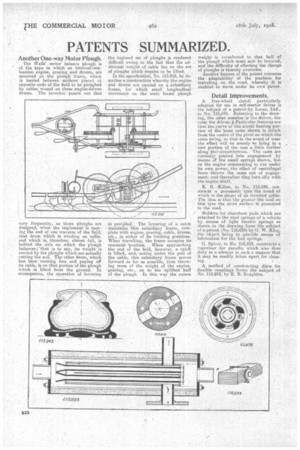PATENTS SUMMARIZED.
Page 22

If you've noticed an error in this article please click here to report it so we can fix it.
• Another One-way Motor Plough.
The Wells' rricitor balance plough is of the 'type in which an interoal-cembustion engine, gearing and drums, are mounted on the plough frame, which
is hauled between anchors placed at opposite ends of the field to be ploughed by cables wound on these engine-driven drums. The inventor leCints out that
very frequently, as these ploughs are designed, when the implement is nearing-the end of one traverse of the field; that drum which is winding on cable, and which is, therefore, almost full, is behind the axto on whichthe plough balancesrthat is to say, its weight is carried by the ploughs which are actually cutting the soil. The other drum,.which has been running free and paying off its cable, is on that, portion of the plough which is lifted from the ground. In
consequence, the operation of lowering
the opposed set of ploughs ,is rendered difficult owing to the fact that the additional weit_.',-1-11 of cable lies on the set Of ploughs which require to be lifted. In the specification, No. 113,016, be describes a construction whereby theengine and drums are carried on a subsidiary frame, for which small longitudinal movement on the main frame plough
is provided: The lowering of a catch
• maintains this subsidiary frame, complete with engine' , gearing, cable, drums, etc., in either of its limiting positions. When travelling, the frame occupies its rearmost 'position. When approaching the end of the field, however, a catch is lifted, and, acting under the pull of the cable, this subsidiary frame moves forward as far as possible, thus throwing more of the weight of the engine, • gearing, etc., on to the. uplifted half of the -plough. In this way the excess weight is transferred to that half of the ploug-h which must new be lowered, and the difficulty•of effecting the change of ploughs is thereby overcome.
Another feature of the patent concerns the adaptability of the machine for travelling on the road, Whereby it is enabled to move under its own power.
Detail Improvements.
A free-wheel clutch particularly adapted for use in self-starter drives is the subject of a paten-b-by Lucas, Ltd.; in N. -U5,878. Referring to the drawing, the outer member is the driver, the inner the driven, f.Particular features are that the curve of the actual bearing portico Of the loose cams' shownis struckfrom the centre of the pivot on which the cants Swing, so that in the event of wear the effect will be merely to bring in a new portien of the cam a little further along the circeinferbnce. The cams are normally pushed into engagement by means of the small springs shown, but on the engine commencing to run under its own power, the effect of centrifugal force throws the cams out of engagement,and thereafter they turn idly with the engine shaft.
E. B. Killen, in. No. 115,945, constructs a -pneumatic tyre the tread of which is the shape of an 'inverted gable. The ideate that the greater -the load on
this tyre the nitire surface presented to the read.
Holders for absorbent pads which are attached to the read springs of a vehicle by Meansof light tension springs as shown in the drawing form the subject of a patent i,No. 116,954) by G. W. King, the object -being to provide means of • lubrication for the leaf springs.
G. Spicer, in No. 115,893, constructs a vaporizerfor paraffin which also does duty as a silencer in such a 111.4.1theE that it may be readily taken apart for cleaning. • A method of constructing discs, for flexible couplings forms the subject of ,No. 115,913, by E. B. Boughton.






















